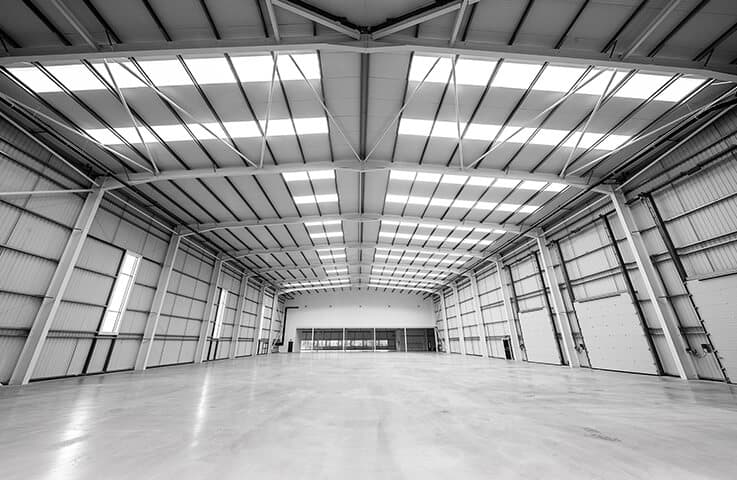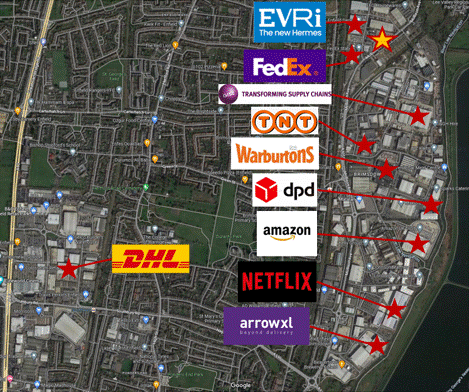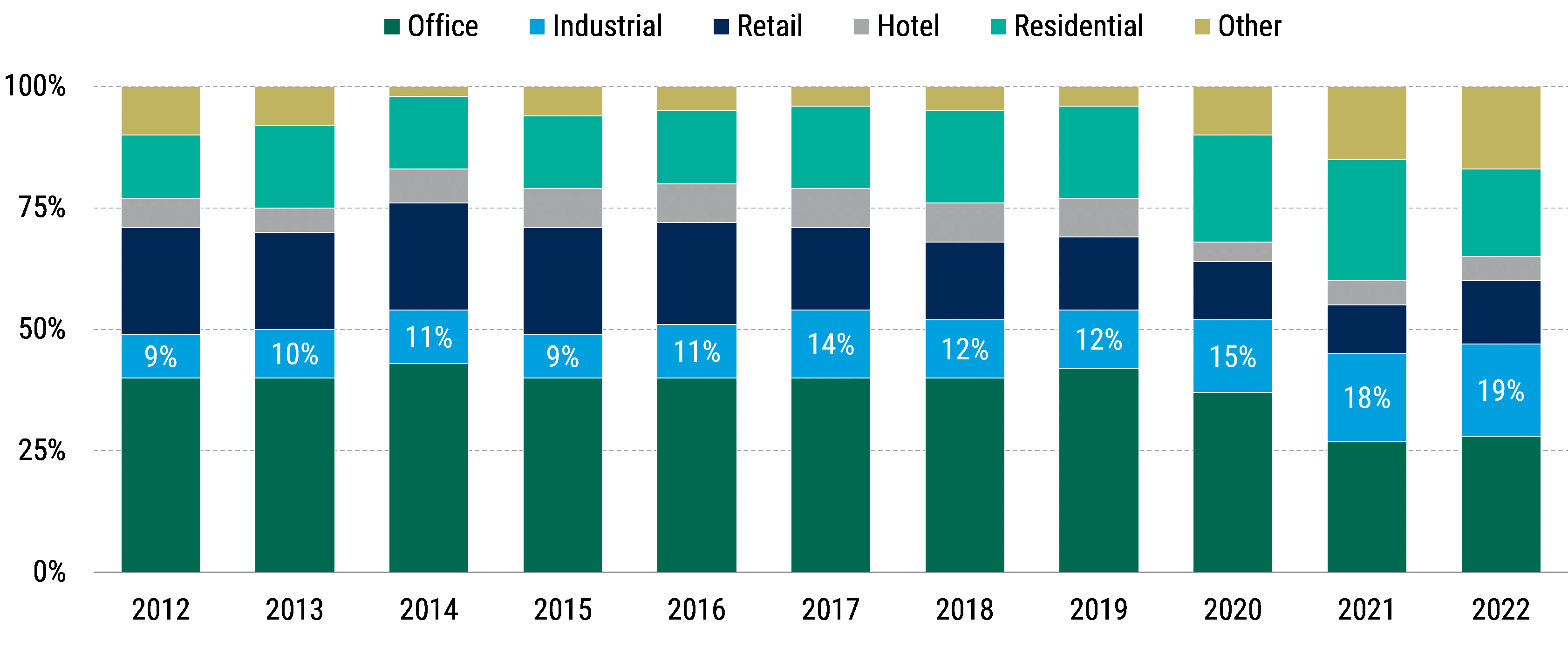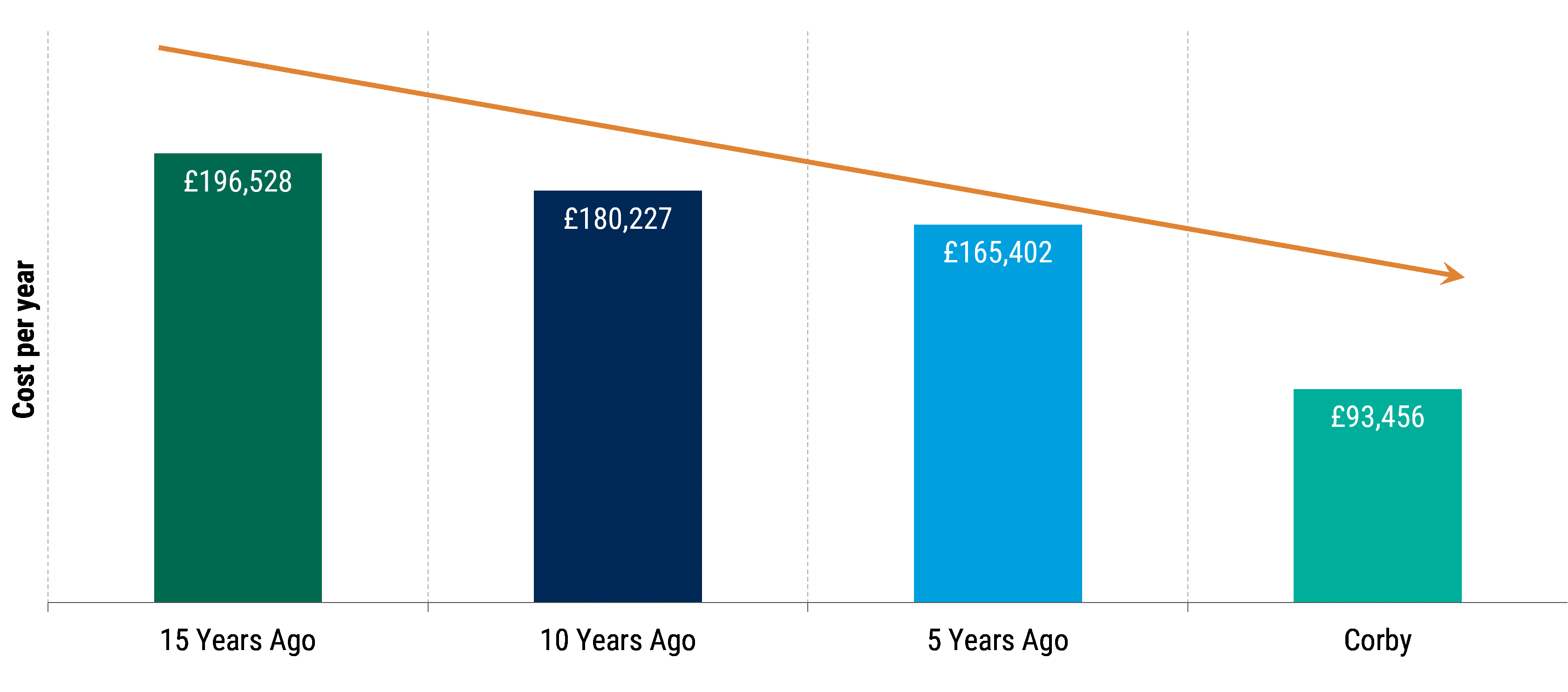The Enduring Appeal of Logistics Hubs: A Closer Look

George MacKinnon
Managing Director

At the height of the pandemic, there might have been no more coveted type of commercial property in Europe than a corrugated steel box sprawled across a couple of acres of land. With the future of offices and retail tossed into doubt by lockdowns, and virtually all non-essential commerce moved online, investors across Europe saw a warehouse – or “shed,” as it’s known in the real estate industry – that could be converted into an ecommerce distribution center as one of the few Covid “winners” the brick-and-mortar world had to offer. “You would go into any meeting and investors just wanted to buy sheds,” Marcus de Minckwitz, head of industry and logistics property for Savills real estate, told The Financial Times last year.1
De Minckwitz’s firm had estimated that for every extra £1 billion spent online, a further 775,000 square feet of warehouse space was needed to meet the new demand. From 2015, when the firm had last commissioned a comprehensive review of the market, through the end of 2020, some 138 million square feet of storage and distribution warehouses were added in the UK alone, a 32% increase.2 According to another report,3 by February 2022 the average UK prime logistics warehouse was generating a total annual return of 45%. So strong was demand, de Minckwitz told the FT, that his firm took to flying drones around the inside of its listings to provide virtual tours.
Today, parts of the European logistics sheds market have softened as surely as demand for the fancy exercise bikes and firepits now gathering dust in many of the same facilities. The sharp rise in inflation in 2022 accelerated the decline, both by driving up building and operating costs, and, even more significantly, by contributing to the rise in interest rates whose previously low levels had helped distort the assumptions used to underwrite the projects. By the second half of 2022, 300,000-square-foot “big box” facilities built on spec on the far distant outskirts of London beyond the M25 ring road were back on the market for less than a third their value of the year before. A number of large, high-profile asset sales were pulled from the market altogether.1
But beneath the surface, the UK and European shed market is stronger than it might seem.
At PineBridge Benson Elliot, our bullishness about sheds stems from three main factors:
Broader logistics tailwinds. The logistics overshoot, painful as it was for those caught in the crossfire, was hardly uniform across the Continent, or even across the sector. In other parts of Europe, such as Italy, where the growth in ecommerce penetration started from a lower base, the logistics buildout is still at a relatively early stage and the market is far less saturated. A growing NIMBY backlash from communities opposing the incipient sprawl of massive distribution centers has added to the supply constraints. Similarly, across Europe, in subsegments such as groceries and last-mile fulfillment – which, by nature, are more constrained by the need for proximity to end customers – the supply-demand dynamics are holding firm, even if at less heated levels than before.
The onshoring and Brexit effect. Growth in ecommerce is just one of the major recent secular tailwinds for sheds. The disruptions of the pandemic and rise in geopolitical tensions these past few years have caused companies across the industrial and logistics landscape to rethink their global supply chains, creating something of a run on sheds to accommodate all or parts of those chains closer to home. The trend has been especially pronounced in the UK, where Brexit has further tipped the scales in favor of onshoring. And this is in a market where the whole thrust of zoning and planning policy over the past 10 to 20 years has been toward residential development, adding to the rise in demand for the industrial land that remains.
The green premium. Sustainability adds another significant complicating factor that can work to the advantage of high-quality shed developers and investors. The same rapidly tightening standards driving a wedge between the haves and have-nots in the European office market are bifurcating the shed market – into one set of properties built to the green specifications of the highest-quality institutional-grade investors and tenants, and everything else. In most European countries, much of the existing stock does not yet meet the requirements of the former group and so is now barreling toward obsolescence, with many premium occupiers likely headed for a move into better-quality digs when their leases are up.
Bottom line. At a time when higher interest rates, a slowing economy, the sustainability-related obsolescence wave, and a looming refinancing cliff present the European commercial property market with some of its toughest challenges in 15 years, many view a green, well-located shed acquired at the right price as still very much a winner.
By the numbers
Other than land itself, investing in sheds is about the purest form of real estate investing there is. What is a shed, after all, but a weatherproof box sitting atop a flat floor on a large (often very large) parcel of land? In a small, densely populated country like the UK, finding strategically located sites for structures that can stretch across the equivalent of three football pitches, or more, is a perpetual challenge. Get it right, in a spot where the economic drivers for the use case(s) run deep, and the demand pressures created can be considerable and enduring. Get it wrong, in locations where land is less scarce and the drivers are weaker, and even in a place like the UK it’s possible to find oneself with just, well, a big empty box.
That’s part of the reason PineBridge Benson Elliot has maintained a healthy skepticism about the UK’s big-box shed boom. It wasn’t just that the demand projections underlying the projects struck us as unrealistic, or the worrying effect of interest rates backing up; it’s that the outlying areas where many of the largest facilities were built had little intrinsic scarcity value. The projects were a commodity, in other words, whose value, much like the share prices of some of the companies fueling the demand, were based on the hope that explosive near-term growth would continue indefinitely, a bet only made more palatable by cheap financing.
To appreciate the speed at which those hopes were dashed, it helps to introduce (a little) math. A simple formula is often used to determine the value of potential shed development projects:
Yield on Cost = Income/Cost
If, for example, the total cost of land acquisition, financing, building, and leasing a shed is £14 million, and the stabilized annual rental income is £1 million, then the projected income return on development of the project, or “yield on cost” (YoC), is 7%. Looking toward the sale of the asset, the value is calculated based on the expected “exit yield,” which is the return the next owner could be expected to earn after paying our targeted asking price, a figure which is used to further back into the ultimate intended return on the project. So, for example, at an exit yield of 5%, the exit value of the same shed (excluding purchasers’ costs) would be £20 million (£1 million divided by 5%), and an estimated £6 million profit may be available, plus any income received before sale.
What happened over the past couple of years was that as interest rates were ultra-low and build costs were stable, many investors found themselves buying into projects with a YoC well below 5%, and were still able to forecast a profit on the basis of a sub-3.5% exit yield. However, as rates and construction costs rose, this pushed up delivery costs (therefore reducing yield on cost) and increased exit yield expectations, resulting in some (or all) of the profit vanishing altogether.
Today, interest rates and other costs have stabilized, but at significantly higher levels than recent historical averages. It’s hard to imagine where the cost base – the denominator in this equation – is going to budge. That means the one sure path back to healthy shed yields is through the numerator – income – at that critical intersection where strong present and future demand meets tight, and firmly circumscribed, supply.
Zooming in
Long before there were sheds, there were factory towns. At the start of the Industrial Revolution, in regions like the English Midlands, the towns originally grew up around the coal mines. In later centuries, even as mining began to wane, steel factories continued to move into the same areas because that’s where the workers were. Similarly, in industrial areas of London, as noxious and unsightly as many considered the factories to be, the plants still needed to be in close enough proximity to the available workforce.
In more recent decades, much of English manufacturing, of course, migrated overseas, and much of zoning and planning policy became geared to cleaning up and repurposing large industrial sites for residential-led mixed-use schemes. According to one study from the Industrial Land Commission, since the turn of this century almost a quarter4 of industrial space in London has been lost to other uses. But, as the tides have shifted again, a new generation of shed tenants find themselves in a similar position to their sooty predecessors: A modern light manufacturing facility still needs to offer a short-enough daily commute to compete for skilled workers.
Companies that relocate the manufacturing of a critical component from China are unlikely to be content setting up the facility out on a remote industrial estate; they’re going to want to locate it near enough their city center offices or university city science parks to keep close tabs on the operations. A subscription streaming service can’t very well expect all the A-list actors it hires to fill its endless content needs to commute an hour-and-a-half each morning from their posh in-town hotels to the studio.
All these forces have brought the latest wave of shed developments, and developers, full circle. Indeed, in many cases we’re having to shoehorn our projects into the very same industrial zones shrunk by decades of disapproval and disuse.
One of our new schemes in north London is typical of these patterns. It’s situated a good 10 km within the M25, squeezed into a typical mixed-income London neighborhood and within a five- to ten-minute drive of some half a million people. As might be expected, the area includes last-mile distribution hubs for both FedEx and Amazon, as well as two large new production studios leased by Netflix. But there are also countless smaller occupiers, with our site immediately adjacent to a metal fabricator, a specialty chemical manufacturer of floor finishings, and a handful of various wholesalers, all of which are typical of these types of industrial areas.
Our north London scheme

At another of our schemes, in Corby, in the former heart of British steelmaking in the East Midlands, it’s been even more back-to-the-future. A 150-acre area is still used to make steel, operated today by India-based Tata. We purchased a plot of land adjacent to the steelworks after a French feed and fertilizer manufacturer shuttered its facility on the property to move its operations back to France in the wake of Brexit. Here, the attraction was the large nearby pool of experienced factory and warehouse workers, but even more, the site’s unique logistical advantages: close to Leicester, Birmingham, Nottingham, Coventry, and Cambridge, as well as the east coast ports. We are on-site, delivering two 170,000 square feet sheds, with both seeing interest from diverse occupier types including third-party logistics providers, modular housebuilders, and food manufacturers and distributors.
Institutional grade
In another sign of the strength and depth of the shed market, interest in the space from large institutional investors, such as pensions funds and endowments, has grown to the point that sheds now eclipse office and retail as the single largest category of institutional property investment globally.
It’s remarkable when you think about it: A decade ago the prototypical institutional real estate holding would have been a prime city-center office building anchored by a Big Eight accounting firm or systemically important bank; today it’s more likely to be a freight handler or nail polish warehouse.
Among Investor Types Overall, Sheds Have Doubled Their Share From 9% in 2012 to 19% in 2023
European Investment Volume Breakdown by Property Type

Source: Knight Frank, February 2023.
As the space has evolved, so have institutional portfolios. Today, institutional sheds essentially fall into two, almost equally important, subcategories: medium to large logistics and distribution facilities, and smaller (roughly 2,000- to 25,000-square-foot) sheds serving a mix of manufacturing and light industrial (known as Multi-Let Industrial) and logistics tenants, as in north London.
Part of the appeal of MLI for institutional investors is the sheer variety of economic exposures it provides. Given the smaller scale of each individual box, the typical institutional shed portfolio can have hundreds if not thousands of tenants spread across the industrial spectrum, making it less likely for economic headwinds to buffet all segments equally.
In addition, these tenants tend to be sticky. Once ensconced at a property with their equipment and related workflows, the businesses are reluctant to leave. Moreover, rent for the shed typically makes up a relatively small portion of their overall operating budgets. The shed market has traditionally lacked intensive, professional-grade management. When an institutional owner steps in, there’s often room to manage the site more professionally and increase rents. The good news (for the owners) is that the proportionally modest hit to the tenants’ own cash flows this entails is usually not enough to meaningfully increase churn.
Institutionalization of the market comes with one catch: Attracting institutional-grade investors often means investing more upfront to create institutional-grade product. That means more modern facilities with better lighting, better paint jobs, a (slightly) better grade of landscaping.
Mostly, though, today it means meeting a much higher level of sustainability: LEED or BREEAM-certified construction; more efficient HVAC systems fed by rooftop solar arrays; state-of-the art ingress and egress to cut down on the emissions from idling trucks; and banks of fast chargers and room to add future-state technologies like hydrogen fueling stations to eventually eliminate the site’s carbon footprint altogether.
All this, of course, takes money, increasing upfront costs, but the energy savings is expected to reduce operating costs. Over the long term, many believe that by attracting better-quality tenants, it can also increase income and yield on cost. It also is expected to improve the chances that the next set of owners and investors will also be institutional grade, deepening the pool of potential buyers, and helping tee up an auction situation, which can help fatten the margins between resale value and construction costs.
A Focus on Sustainability Can Reduce Operating Costs

Source: Cudd Bentley Consulting, March 2023.
So, why do so many sophisticated investors like sheds? When underwritten prudently, sited strategically, and built to today’s and tomorrow’s highest standards, what’s there not to like?
Footnotes
1 “The End of the Warehouse Bubble,” The Financial Times (7 August 2022).
2 “The Size and Makeup of the UK Logistics Sector—2021,” Savills (28 June 2021).
3 “Prime Logistics, The Definitive Guide to the UK’s Distribution Property Market,’’ Gerald Eve, Q1 2022.
4 “Making Space: Accommodating London’s industrial future,” Report for the Industrial Land Commission (January 2022).
Disclosure
Investing involves risk, including possible loss of principal. The information presented herein is for illustrative purposes only and should not be considered reflective of any particular security, strategy, or investment product. It represents a general assessment of the markets at a specific time and is not a guarantee of future performance results or market movement. This material does not constitute investment, financial, legal, tax, or other advice; investment research or a product of any research department; an offer to sell, or the solicitation of an offer to purchase any security or interest in a fund; or a recommendation for any investment product or strategy. PineBridge Investments is not soliciting or recommending any action based on information in this document. Any opinions, projections, or forward-looking statements expressed herein are solely those of the author, may differ from the views or opinions expressed by other areas of PineBridge Investments, and are only for general informational purposes as of the date indicated. Views may be based on third-party data that has not been independently verified. PineBridge Investments does not approve of or endorse any republication of this material. You are solely responsible for deciding whether any investment product or strategy is appropriate for you based upon your investment goals, financial situation and tolerance for risk.
